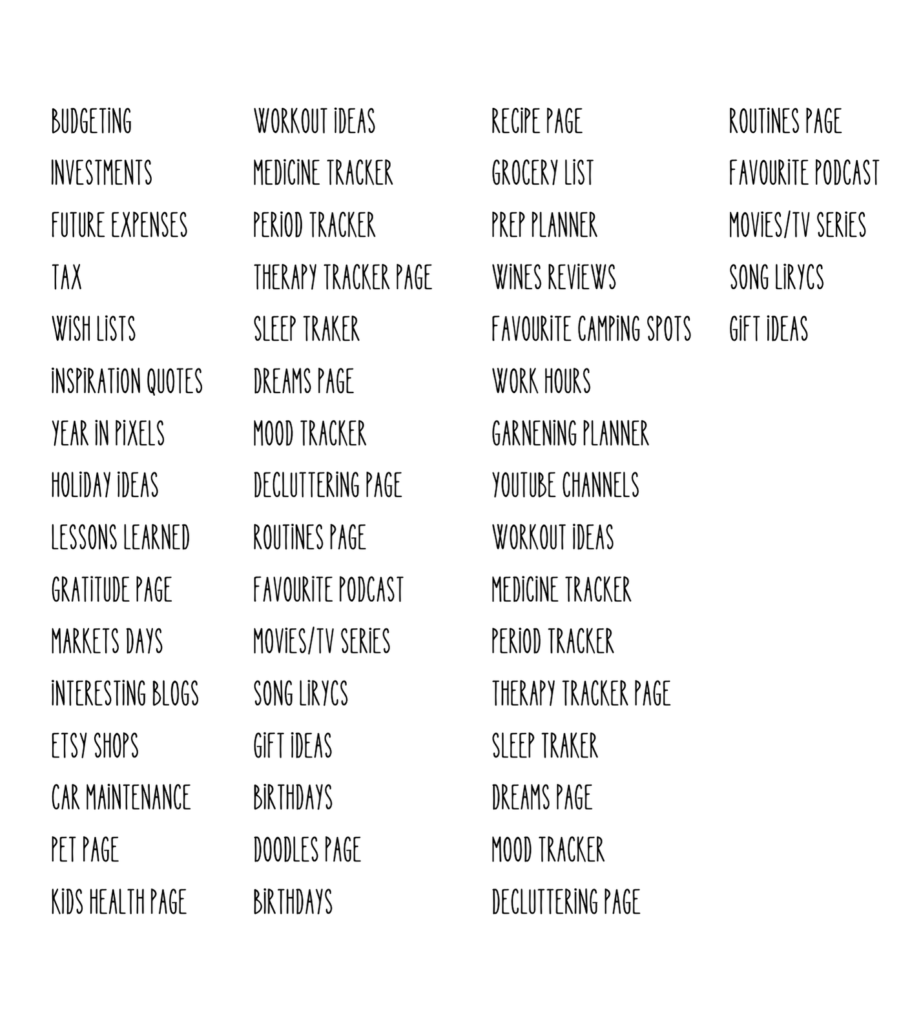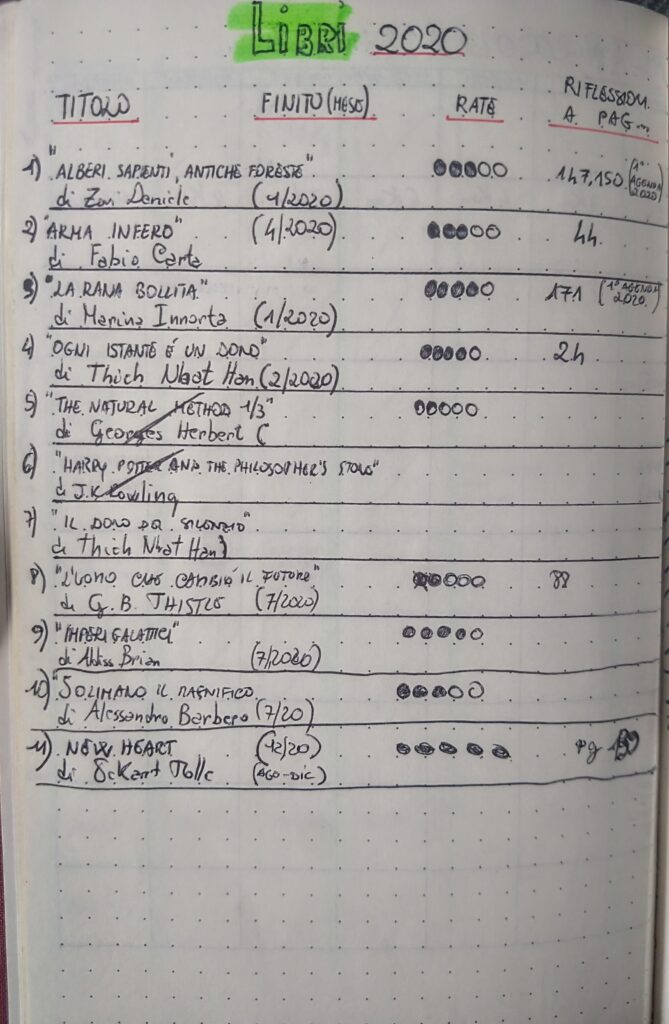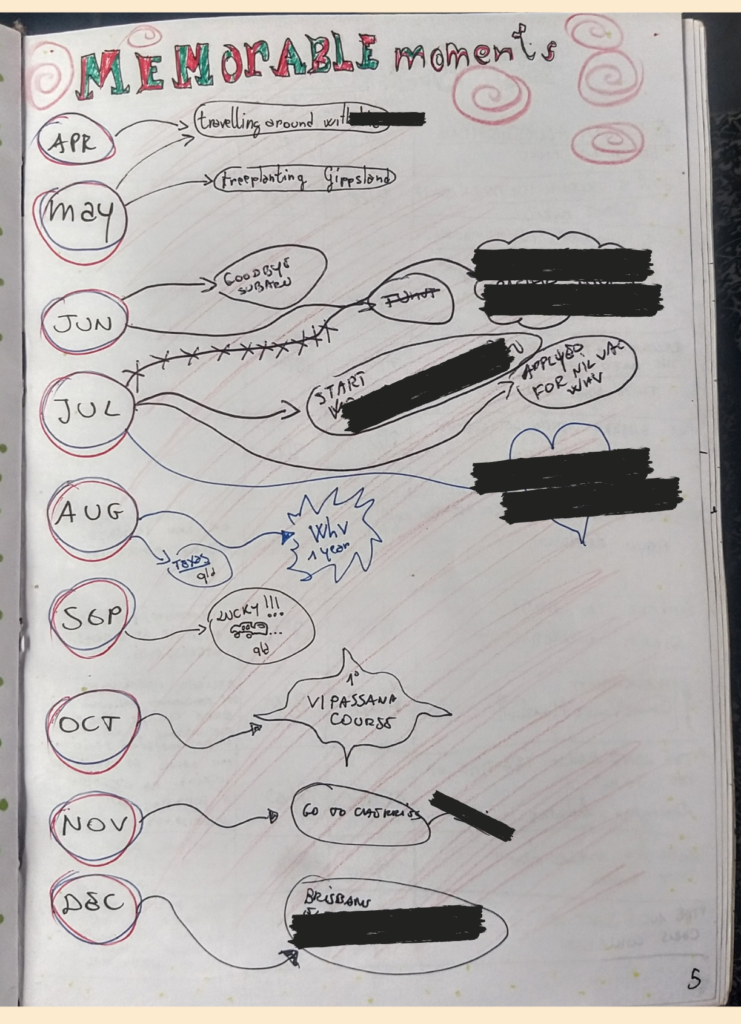
Chapter 5
Journaling starter Kit
for Beginners

Chapter 5:
Your journal is at your service.
Other Special Pages!
Special pages are a great feature of your journal, they are tools that help you manage, organize, or track different aspects of your life, or they can be purely for your personal enjoyment. You can create a special page about anything.
Even the pages I illustrated in the previous chapter are special pages, but I consider them highly functional to the purpose of your journal, whatever that may be. However, it might be that, depending on your particular goals, you need to create other special pages.
For example, if your goal is “Read 24 books in a year,” after organizing your goal and your tracker, you might create an additional special page with a list of the books you want to read.
Or you could combine your tracker with the special page “Book List.” In short, the possibilities are endless.
Here are some tips I’d like to share with you regarding special pages:
- You don’t have to add too many pages, my advice is not to choose more than 3 to 5 if you are a complete beginner;
- try different pages over time;
- you can add Special page at any moment, as you realize what you need;
- It might happen that you add a special page to your journal and then never use it. Don’t feel obligated to use it; it simply wasn’t necessary for you. Just move on.
- Remember to add each special page to the index; otherwise, they’ll get lost in your journal.

My favorite special pages
We’re almost at the end, and I want to show you some of the special pages that have accompanied me throughout these years.
Some were inspired by different “journalers” over the years, while others I created from scratch based on my needs.
I’m showing them to you for demonstration purposes only, so don’t feel obligated to include them, as they are perfect for me but may not be for you. I’m sharing them just to give you an idea of how I personally organize my journal.
- The Library of the Year;
- The Memorable Moments;
- Life Areas,
- Direction and Values Pages;
- The Review, monthly or yearly;
- The Brain Dump;
- The Next Year Summary.
1. The Library of the Year

As you can guess it is the list of books read during the year, you can also create a similar page for TV series or movies. Online you can find many layouts that are beautiful and colorful but mine is really minimal.
A list, with Title, Author, 1/10 rating and a short comment (if I deem it necessary).
If the comment is very long, I write it on a daily page and note the page number in the comment section.
It is concise, short and effective.
You can decide to make it more complex, leaving more room for notes and comments.
You can set it up at the beginning of your journal, after the essentials, or add it when you have the first book to jot down.
Depending on how much space you decide to leave for your notes you can dedicate a page or two. But remember that you can always create another Library page later, at any time, and add it to the index.
2. The Memorable Moments

This page is really simple but I find it really useful for reconstructing the year in a single glance.
It is a page with the months written in a list on the left.
Each event that I consider important is on the right connected with an arrow to the month in which it took place.
This is for the full year but it can also be monthly. Very simple.
3. Life Areas, Direction and Values Pages

Over the years I have collected reflections and thoughts on it. Rereading and summarizing them, this is my result.
I’m particularly proud of this page because it is the result of a lot of introspection, it is the summary of my personal growth up to now, and I can say that it is the heart of my journaling. It guides me in choosing my goals, and is able to tell me if they align with my values.
It is the compass that guides my actions, it reminds me of who I am and where I want to go, who I can be.
Sometimes it might happen that as we progress toward achieving a goal, we feel increasingly unhappy. These are the main reasons that I have found to be true:
- It can simply be because we are not keeping the promise we made in the beginning:
“I will NOT demand perfection, from Myself, from My journal and from My life!” - Or it can be that we decided a Goal outside our possibilities and we don’t have the necessary resources (yet). In this case we have to start with getting the resources we need (therefore, often a different goal).
- Sometimes, however, it is just because we have set a goal that goes against our most intimate values. This happened to me personally before I identified what my values truly were.
Having clear values is essential, and too often we take for granted that we know them perfectly. Unfortunately this is not always the case.
Knowing how to deeply recognize and identify our values is necessary to continue in the right direction, the right direction “for you”!
Direction comes as a result, as does the Vision of what you can become. You know who you really are and you know that by sticking to your Values, even if it means making sometimes very difficult choices, you will be true to yourself.
Life Areas are the areas in which I have summarized every aspect of my life. This is useful for me to manage the confusion, to reflect on a particular area, or when I want to review a period of time.
- Work (Everything related to my economic independence);
- Health and Movement (everything related to mental and physical health)
- Spirituality and Relationships (Everything related to the connection with the spiritual and relational world)
- Edification (everything that enriches me, in terms of study or personal enjoyment)
4. The Reviews, Monthly, Yearly, or periodical
The reviews are an important moment that I take for myself, a way to set a new beginning and sum up what has been experienced up to that moment.
Usually when I decide to do a review I reread everything I’ve written for a certain period (it can be a month, or a year, or an intermediate period) and then I make a summary for each Area of Life, trying to underline:
- What went well;
- What went wrong;
- What can I actually (realistically) do to improve.
You may decide to have a set of questions to answer every month, always the same and see your evolution month by month. You can include some reflections on the progress of your goal in your review, always keeping in mind a perspective of growth and improvement, but with kindness toward yourself.
5. The Brain Dump
This special page is an emergency tool and is universally used by “journalers” all around the world. It happens to everyone in everyday life to feel overwhelmed and have the sensation that chaos and confusion takes over, and thinking, journaling, or organizing yourself becomes nearly impossible.
In those cases, it’s time to use the Brain Dump technique.
This is the simplest page ever, its only purpose is to “clean your brain”!
Open your journal, and on the first blank page, write everything down: words, actions, thoughts, sounds, images, worries, emotions, EVERYTHING. You have to write everything you have in mind.
You have to throw everything away without order, without criteria, without rules, without fear.
Do not even worry about writing inside the lines or squares, just write wherever you feel like writing without thinking too much.

Brain Dump.
KEY TIP: The Brain Dump should not be reused to create to do lists, I advise you not to. This page is a cleanup tool. After you “dump away” everything, you should leave your brain alone and wait a while.
Return to your journal and if you need to, you can write a to-do list of your urgencies, or a slightly more lucid reflection. But don’t use the brain dump as a to do list.
Use a fresh page every time you need to use the brain dump technique.
6. The Next Year Summary
I find the Next Year Summary very useful personally, so I always include one right after the Year Calendar I mentioned in the Essentials chapter.
You can decide to add a Next Year Summary for the future year, basic, yet useful for important reminders (deadlines, events, important “DO NOT FORGET” dates).
I use it to remind myself of deadlines or to renew subscriptions or annual fees.
I’ve included a Next Year Summary in the printable pages, but you can quickly hand write it if you want.

Journaling Starter Kit for Beginner – Free Printable.
As promised, to help you on this journey, I’m sharing some simple printables to get your journal started on the right foot.
In the zip folder, you will find the files for:
- Simple Week Page;
- Simple Montly Calendar;
- Year Calendar;
- Next Year Summary;
- Goal Tracker.
Print them to the correct size for your journal, or you can print them just to have a reference when you need to create one of the pages.
The choice is yours.
THE END:
Let’s make order.
We’ve reached the end, but I understand if you’re feeling a bit confused with all this information, especially if you’re a beginner ‘journaler’.
Below is an example of one of my index to give you an idea of the order of the pages.

As you can see, this site is brand new. I’ve been working on Journaling Now early each morning before heading to my job, eagerly anticipating the day I could finally launch it.
Countless hours have gone into creating Journaling Now, so I hope this guide has been helpful and has inspired you to start your journaling practice.
My goal is to create a small community, publish 2-4 articles per month, and foster discussions and exchanges for those interested in journaling. I have many ideas in the works for Journaling Now.
If you’d like to be part of the growing Journaling Now community and receive the latest articles and other free journaling content, sign up for the newsletter.
And if you have any questions or requests for more information, feel free to reach out through the comment or contact section.
Thank you for reading this far, and I’ll see you in the next article.
Happy journaling!

Sign up for the newsletter.
Stay updated on new articles and initiatives from Journaling Now.
